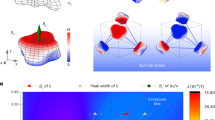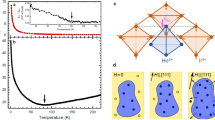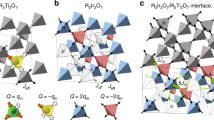Abstract
The idea of magnetic monopoles in spin ice has enjoyed much success at intermediate temperatures, but at low temperatures a description in terms of monopole dynamics alone is insufficient. Recently, numerical simulations were used to argue that magnetic impurities account for this discrepancy by introducing a magnetic equivalent of residual resistance in the system. Here we propose that oxygen deficiency is the leading cause of magnetic impurities in as-grown samples, and we determine the defect structure and magnetism in Y2Ti2O7−δ using diffuse neutron scattering and magnetization measurements. These defects are eliminated by oxygen annealing. The introduction of oxygen vacancies causes Ti4+ to transform to magnetic Ti3+ with quenched orbital magnetism, but the concentration is anomalously low. In the spin-ice material Dy2Ti2O7 we find that the same oxygen-vacancy defects suppress moments on neighbouring rare-earth sites, and that these magnetic distortions markedly slow down the long-time monopole dynamics at sub-Kelvin temperatures.
This is a preview of subscription content, access via your institution
Access options
Subscribe to this journal
Receive 12 print issues and online access
$259.00 per year
only $21.58 per issue
Buy this article
- Purchase on Springer Link
- Instant access to full article PDF
Prices may be subject to local taxes which are calculated during checkout





Similar content being viewed by others
References
Harris, M. J., Bramwell, S. T., McMorrow, D. F., Zeiske, T. & Godfrey, K. W. Geometrical frustration in the ferromagnetic pyrochlore Ho2Ti2O7 . Phys. Rev. Lett. 79, 2554–2557 (1997).
Bramwell, S. T. & Gingras, M. J. P. Spin ice state in frustrated magnetic pyrochlore materials. Science 294, 1495–1501 (2001).
Ramirez, A. P., Hayashi, A., Cava, R. J., Siddharthan, R. B. & Shastry, S. Zero-point entropy in ‘spin ice’. Nature 399, 333–336 (1999).
Siddharthan, R. Ising pyrochlore magnets: Low temperature properties, ice rules and beyond. Phys. Rev. Lett. 83, 1854–1857 (1999).
Den Hertog, B. C. & Gingras, M. J. P. Dipolar interactions and origin of spin ice in Ising pyrochlore magnets. Phys. Rev. Lett. 84, 3430–3433 (2000).
Pauling, L. The structure and entropy of ice and other crystals with some randomness of atomic arrangement. J. Am. Chem. Soc. 57, 2680–2684 (1935).
Castelnovo, C., Moessner, R. & Sondhi, S. L. Spin ice, fractionalization and topological order. Annu. Rev. Condens. Matter Phys. 3, 35–55 (2012).
Castelnovo, C., Moessner, R. & Sondhi, S. L. Magnetic monopoles in spin ice. Nature 451, 42–45 (2008).
Morris, D. J. P. et al. Dirac strings and magnetic monopoles in the spin ice Dy2Ti2O7 . Science 326, 411–414 (2009).
Fennel, T. et al. Magnetic Coulomb phase in the spin ice Ho2Ti2O7 . Science 326, 415–417 (2009).
Kadowaki, H. et al. Observation of magnetic monopoles in spin ice. J. Phys. Soc. Jpn 78, 103706 (2009).
Giblin, S. R., Bramwell, S. T., Holdsworth, P., Prabhakaran, D. & Terry, I. Creation and measurement of long-lived magnetic monopole currents in spin ice. Nature Phys. 7, 252–258 (2011).
Snyder, J. et al. Low temperature spin freezing in the Dy2Ti2O7 spin ice. Phys. Rev. B 69, 064414 (2004).
Ryzhkin, I. A. Magnetic relaxation in rare-earth oxide pyrochlores. J. Exp. Theoret. Phys. 101, 481–486 (2005).
Jaubert, L. D. C. & Holdsworth, P. C. W. Signature of magnetic monopole and Dirac string dynamics in spin ice. Nature Phys. 5, 258–261 (2009).
Quilliam, J. A., Yaraskavitch, I. R., Dabkowska, H. A., Gaulin, B. D. & Kycia, J. B. Dynamics of the magnetic susceptibility deep in the Coulomb phase of the dipolar spin ice material Ho2Ti2O7 . Phys. Rev. B 83, 094424 (2011).
Matsuhira, K. et al. Spin dynamics at very low temperature in spin ice Dy2Ti2O7 . J. Phys. Soc. Jpn 80, 123711 (2011).
Yaraskavitch, L. R. et al. Spin dynamics in the frozen state of the dipolar spin ice material Dy2Ti2O7 . Phys. Rev. B 85, 020410 (2012).
Revell, H. M. et al. Evidence of impurity and boundary effects on magnetic monopole dynamics in spin ice. Nature Phys. 9, 34–37 (2013).
Lau, G. C. et al. Zero-point entropy in stuffed spin ice. Nature Phys. 2, 249–253 (2006).
Longo, J. M., Raccah, P. M. & Goodenough, J. B. Pb2M2O7−x (M = Ru, Ir, Re)–preparation and properties of oxygen deficient pyrochlores. Mater. Res. Bull. 4, 191–202 (1969).
Subramanian, M. A., Aravamudan, G. & Rao, G. V. S. Oxide pyrochlores–a review. Prog. Solid. State Chem. 15, 55–143 (1983).
Welberry, T. R. IUCr Monographs on Crystallography 16, Diffuse X-ray scattering and models of disorder. (OUP, (2004).
Welberry, T. R. Diffuse X-ray scattering and models of disorder. Rep. Prog. Phys. 48, 1543–1593 (1985).
Gutmann, M. J. Accelerated computation of diffuse scattering patterns and application to magnetic neutron scattering. J. Appl. Cryst. 43, 250–255 (2010).
Ross, K. A. et al. Lightly stuffed pyrochlore structure of single-crystalline Yb2Ti2O7 grown by the optical floating technique. Phys. Rev. B 86, 174424 (2012).
Hayes, W. & Stoneham, A. M. Defects and Defect Processes in Non-Metallic Solids (Wiley, (1984).
Henley, C. L. NMR relaxation in spin ice due to diffusing emergent monopoles I. Preprint at http://arxiv.org/abs/1210.8137 (2012)
Biltmo, A. & Henelius, P. Unreachable glass transition in dilute dipolar magnet. Nature Commun. 3, 857 (2012).
Paulsen, C. et al. Far-from-equilibrium monopole dynamics in spin ice. Nature Phys. 10, 135–139 (2014).
Castelnovo, C., Moessner, R. & Sondhi, S. L. Thermal quenches in spin ice. Phys. Rev. Lett. 104, 107201 (2010).
Levis, D. & Cugliandolo, L. F. Out of equilibrium dynamics in the bidimensional spin-ice model. Europhys. Lett. 97, 30002 (2012).
Levis, D. & Cugliandolo, L. F. Defects dynamics following thermal quenches in square spin-ice. Phys. Rev. B 87, 214302 (2013).
Mostame, S., Castelnovo, C., Moessner, R. & Sondhi, S. L. Tunable nonequilibrium dynamics of field quenches in spin ice. Proc. Natl Acad. Sci. USA 111, 640–645 (2014).
Prabhakaran, D. & Boothroyd, A. T. Crystal growth of spin-ice pyrochlores by the floating-zone method. J. Cryst. Growth 318, 1053–1056 (2011).
Hutchings, M. T. in Solid State Physics 16 (eds Seitz, F. & Turnbull, D.) Point-charge calculations of energy levels of magnetic ions in crystalline electric fields. –273 (Academic, 1964).
Acknowledgements
We thank M. Jura and T. Lehner for their help, and B. Gaulin, M. T. Hutchings, K. Refson, R. Moessner, S. L. Sondi, S. Dutton and U. Karahasanovic for helpful discussions. We acknowledge support from the South East Physics Network and the Hubbard Theory Consortium, and we are grateful for the financial support and hospitality of ISIS. This work was supported in part by EPSRC grants EP/G049394/1, EP/H033939/1 and EP/K028960/1, NSERC, the Helmholtz Virtual Institute ‘New States of Matter and Their Excitations’, and the EPSRC NetworkPlus on ‘Emergence and Physics far from Equilibrium’.
Author information
Authors and Affiliations
Contributions
J.P.G., C.C. and D. Prabhakaran designed the research. The neutron measurements were performed by G.S., M.J.G. and J.P.G.; the X-ray diffraction was performed by D.G.P. The crystals were grown by D. Prabhakaran The d.c. magnetization was measured by D. Prabhakaran and G.S. and the magnetic relaxation measurements were performed by D. Pomaranski, C.M. and J.B.K. Theoretical modelling and simulation was by G.S., M.J.G. and C.C. The manuscript was drafted by J.P.G., C.C. and G.S. and all authors participated in the writing and review of the final draft.
Corresponding author
Ethics declarations
Competing interests
The authors declare no competing financial interests.
Supplementary information
Supplementary Information
Supplementary Information (PDF 1759 kb)
Rights and permissions
About this article
Cite this article
Sala, G., Gutmann, M., Prabhakaran, D. et al. Vacancy defects and monopole dynamics in oxygen-deficient pyrochlores. Nature Mater 13, 488–493 (2014). https://doi.org/10.1038/nmat3924
Received:
Accepted:
Published:
Issue Date:
DOI: https://doi.org/10.1038/nmat3924
This article is cited by
-
Spin polarized Fe1−Ti pairs for highly efficient electroreduction nitrate to ammonia
Nature Communications (2024)
-
Defect-induced monopole injection and manipulation in artificial spin ice
Nature Communications (2022)
-
Role of defects in determining the magnetic ground state of ytterbium titanate
Nature Communications (2019)
-
Phase transitions in few-monolayer spin ice films
Nature Communications (2019)
-
Advanced High-Temperature Structural Materials for Aerospace and Power Sectors: A Critical Review
Transactions of the Indian Institute of Metals (2019)



